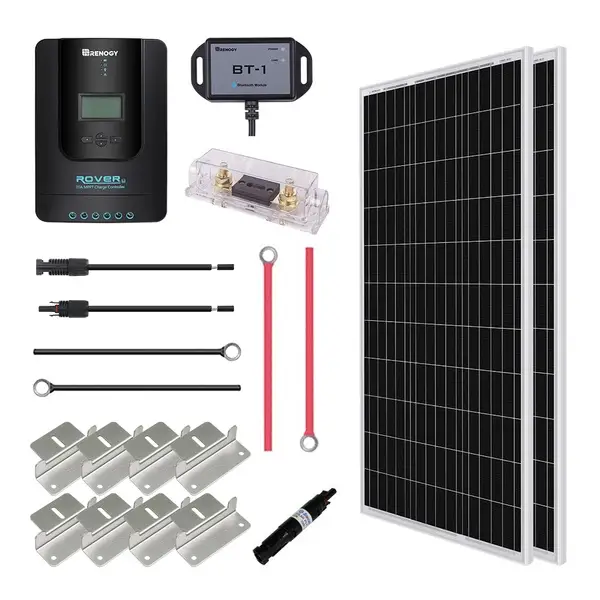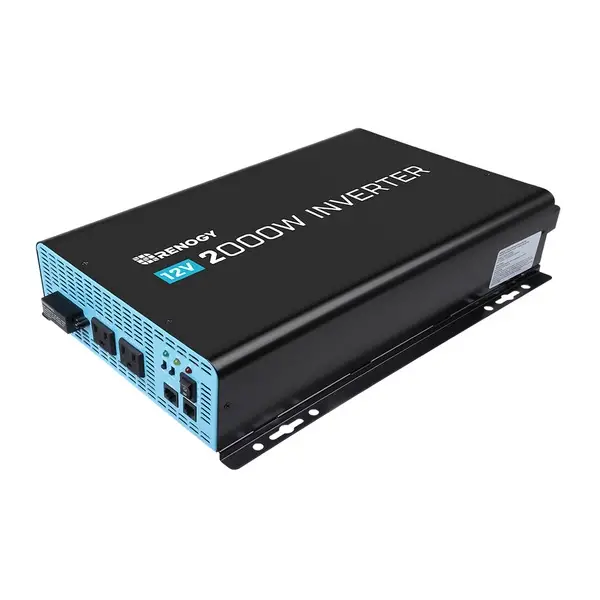Hi-van is supported by its audience. When you purchase using our links, we may earn an affiliate commission (no added cost to you). Learn more
An increasing number of adventurers have discovered the beauty and excitement of living in a van. For how living on the road can represent the ultimate adventure, some matters can bring you back to everyday life issues. One of these is powering your appliances and recharging your devices – all extremely important, especially if you live a digital nomad lifestyle.
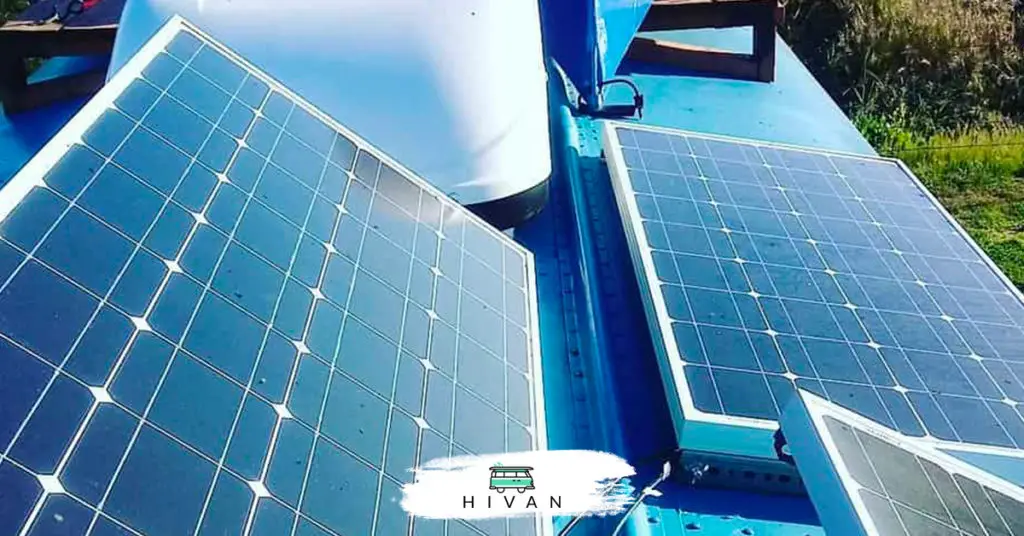
Depending on the power audit, your van needs 100 to 1200 watt solar panels array. A solar power array is a sustainable way to deliver DC or AC/DC power to your van. If you have a high-quality battery (AGM or Lithium) that allows for extra storage, you can consider smaller solar systems.
Picking the best
A Solar Power System for Your Van: An Overview

When installing the first solar system for your van, there are several factors van-lifers should consider. Indeed, the panels represent only one of the components of a well-thought system. However, batteries, inverters, geographical location, and roof space will also influence your decisions.
In this brief overview, you will find out about the measurements we will use in the sections below, and the factors determining the solar system’s size. If you are in a rush, the video below can also offer you valuable insights:
Watts, Volts, Amp-Hours, and Usable Amp-Hours
In simple terms, amp, volts, watts are:
- Ampere or Amp – the amount of power that is available
- Volts – the pressure of the power available
- Watts – the power created by the electricity, calculated as Amps x Volts
To understand your battery life and power:
- Amp-hours or Ah – the amp-hour rating refers to the amperage the battery can provide for one hour.
- Usable Amp-Hours – the real Ah a battery can deliver (varies depending on the type of battery you have picked; it is much higher for Lithium batteries, while AGM batteries run at 50% of nominal Ah capacity). It depends on the battery’s Depth of Discharge (DOD).
Factors Determining Your Solar System’s Size
Picking the right-size solar system is not an easy task. Indeed, it can be influenced by the following factors:
- The results of your solar power audit (or the wattage needed to run your devices and electronics)
- The type of battery picked (Lithium batteries are more efficient and can store more usable power, while more affordable batteries will require you to have a larger system)
- The amount of sunlight in a day (in the US, this is around 6 hours per day, but it can change)
- The usable portion of your van’s roof
- The use you make of your van
Conducting a Solar Power Audit
Unfortunately, when it comes down to designing the perfect solar power system for your van, you can apply no one-fits-all solution. Indeed, depending on the size of your van, the use of your make of it, your devices and appliances, and your personal needs, you might require a more or less powerful system.
While the solar panels systems make up for only one component of a comprehensive solar system, you should not overlook the importance of understanding how much power your van actually needs. And you should do so before investing in any of the system’s components, as you will need to match them for enhanced efficiency.
Don’t hesitate to use the solar calculator made by Renogy, it will help you a lot.
Here is what to keep in mind, but here is a quick video that can offer you an interesting overview if you are short on time:
Why Conduct a Solar Power Audit?
Several different factors and features need to be considered before opting for a specific wattage for your
Performing your van’s audit and understanding what electronics, devices, and appliances you use daily can help you make the right choice. Indeed, these are the components of your van that will need to be charged daily or need electricity to run during the day.
In any case, a van that is completed with a fridge, air conditioning system, or even a TV will need much more power than a campervan that runs almost entirely on gas and will only use electricity for lighting at nighttime.
How to Conduct a Solar Power Audit on Your Van
Conducting a solar power audit on your van is a straightforward process that any first-time van lifer can perform without the help of an expert.
- You should start by counting and recording all the devices and appliances that need electricity to be charged or run.
- Then, find out the power consumption rating of each device and appliance. You can do so by checking the device’s output wattage (W) (usually found on a sticker or the battery panel).
- If you can’t find the wattage, you might find the output voltage (V) and amperage (Amp). In this case, you can determine the device’s wattage by multiplying the output volts and the amperage.
- Add up the voltage of each device and record it.
- Estimate how long you will be using each and charging each device (8 hours a day/7 days a week is an optimal reference).
This quick addition will give you an idea of how powerful your
Find this content useful 🙂 ?
Subscribe to our Newsletter and get a free Solar Electric Diagram + shopping list.
The Importance of Batteries for Your Solar Power System
When starting to think about installing a
So, even if picking the right solar panels is crucial, investing in high-quality batteries is even more important. Indeed, the highest is the batteries’ efficiency, the smaller the solar panels system can be.
Types of Batteries Available for Your Solar Power System
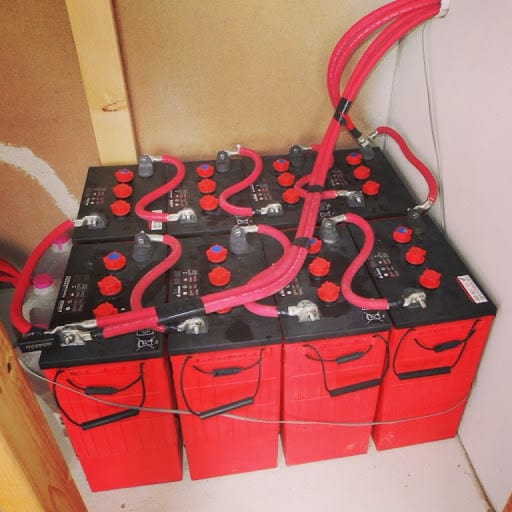
While high-efficiency Lithium batteries are a dream for any van-lifer, they often don’t fit budget and space requirements. Luckily, some options are worth considering. These are:
- Flooded Lead-Acid (FLA) – FLA batteries are among the cheapest options for van-lifers, but they also boast one of the oldest technologies in terms of chemical composition. They require high levels of maintenance, including ventilation, watering, and equalization charges.
- Gel Batteries – these batteries work similarly to FLA and AGM batteries. While they are lead-acid batteries, they don’t require as much maintenance as FLA batteries, but they still need to be tested and cleaned. They are affordable but not as efficient as other models.
- Absorbed Glass Mat (AGM) Batteries – these batteries are one of the most popular choices for van-lifers. They are relatively affordable and efficient, and they can last for years if you don’t allow them to drop below 50% power.
- Lithium-Ion Batteries – LiFePO4 batteries are the best, premium choice for van-lifers. They are undoubtedly expensive and hardly fit anybody’s budget due to the high upfront cost. However, they are incredibly low-maintenance and high-efficiency, so you will likely see a return on investment if you live full-time in your van.
Determining the Usable Amp-Hours of Your Battery
So far, you learned that solar panels are what charges your van’s batteries, and your batteries are what deliver power to your devices and appliances. In turn, the size and number of your batteries should be adequate for the number of devices you need to charge and the hours they are usually in use.
You would have figured out how many watts or Amp-hours (Ah) of batteries you need to run your van. Starting from your batteries’ nominal amp-hours, the next step is to understand how many Amp-hours are actually usable – which depends on the DOD (Depth of Discharge).
- If you have invested in Lithium batteries, the total Amp-hours of the batteries will be usable. For example – a 1x100Ah Lithium battery will deliver 100Ah. 2x100Ah Lithium batteries will deliver 200Ah.
- If you have AGM or lead-acid batteries, the usable Amp-hours will be half of the nominal Amp-hours. For example – a 1x100Ah AGM battery will deliver 50Ah. 2x100Ah AGM batteries will deliver 100Ah.
The USABLE Ah of your batteries is what determines the size of your solar system. This is how you calculate it:
- 100 usable Ah has 1280watts of power for your devices (100Ah x 12.8volts of a standard battery = 1280watts)
- Consider the hours of sunlight – in the US, 6 hours on average.
- Your solar panels will need to be able to deliver 1280watts in 6 hours to your batteries for a full charge in a day.
- 1280watts ÷ 6 hours = 213watts. 213watts is the size of your solar panels.
Van-lifers should also keep in mind that the larger the
If you have limited roof space and can just achieve the level of power needed, remember that you can always use an alternator or shore power to fill your batteries.
Choosing an Inverter That Works for Your Van
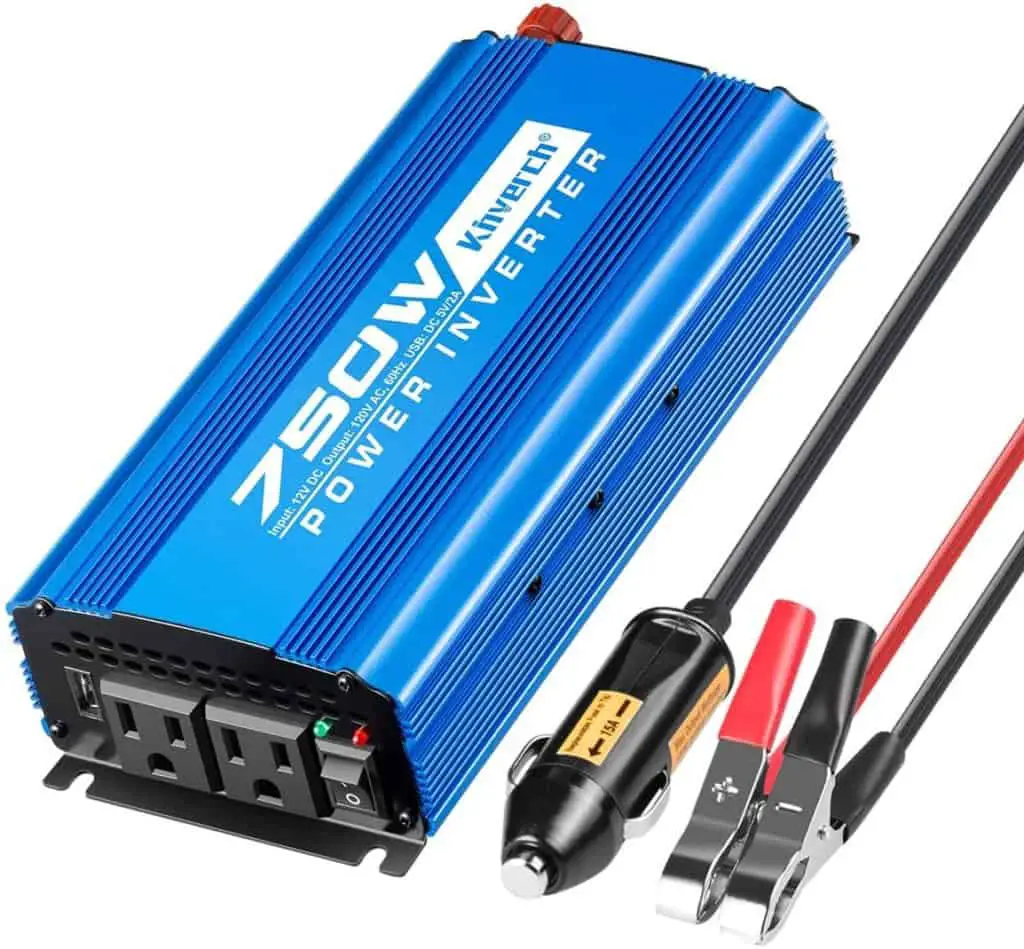
When planning the
Indeed, the solar panels work on DC, but your home or van appliances work on AC. So, without an inverter, your solar panels won’t be able to send current to your fridge, TV, or AC system.
Solar power inverters come in a range of sizes, and they play an essential role when it comes down to picking the appropriate size of your
This array-to-inverter ratio should be between 1.15 and 1.25. To calculate the ratio, you should understand your solar panels’ watts and the watts of your inverter. For example, if you have a 500 watts system and a 400 watts inverter, the ratio will be 1.25 (500÷400).
When picking the right inverter for your van, don’t forget that a smaller size often indicates higher efficiency. Additionally, there is no need to burn a large portion of your budget on a larger inverter if your solar panels array won’t deliver more than 600-1200 watts.
Solar Panels Systems: Overview and Measurements
One of the first questions van-lifers ask when deciding on their solar system is, “How many solar panels do I need?” However, your solar system’s power and efficiency are not determined by the number of panels but by the wattage of your array.
Solar panels come in many sizes and wattages, and each panel will contribute to the total wattage of the array.
Today, you can find solar panels that come in different wattages such as:
- 100W
- 170W
- 200W
- 225W
- 265W
- 300W
- 335W
- 360W
- And many more
To determine the total wattage of your solar system, you will only need to multiply each panel’s wattage by the number of panels you have installed.
For example, if you have three panels of 100watts each, they will deliver 300watts of power to the batteries (3 x 100watts = 300watts).
Depending on the solar panels you have installed, you will benefit from different wattages for your batteries. But as you can see, the batteries you have picked, as well as your solar power audit and inverter, will weigh on the decision of what solar panels to mount.
How Many Watts of Solar Power Do You Need?
Now that you have a better understanding of how solar panels are measured and why wattages count more than the number of panels let’s look at your van’s realistic needs.
Firstly, use the sections above to conduct a solar power audit and determine the size, number, and type of the batteries you need to run your devices and appliances. Measure that in watts. If only output volts and amps are shown on the device, multiply the two figures to find out the wattage needed.
So, to determine the size of your solar system, what you will need are:
- The total wattage needed to run your van
- The number of hours you will keep your devices in use
- The hours of sunlight
- The kind of inverter you have
- The size, type, and usable Ah of your batteries
Then, a simple way to determine the power you need from each
Generally, you will need 200watts worth of solar panels per 100 usable Ah of batteries.
With lead-acid and AGM batteries, the usable Ah corresponds to half of the nominal Ah (as seen above).
For example, if your batteries boast 300 usable Ah, you will need your solar panels to deliver 600watts.
Now that you have the total amount of power you need, you will need to calculate the number of panels you will fit on the van’s roof. This will depend on your van’s size and the use you make of its roof.
If you only want to fit two solar panels and need 600watts worth of power, each of the panels will need to contain 300watts. Alternatively, if you want to install six panels, they can only need to contain 100watts each.
Quick Solutions for Your Van
Depending on the way you use your van, you will have different power requirements. For example, your energy use will be different if you plan a full-time, off-grid lifestyle or just use your van for weekend adventures.
The sections above explained in detail how to find the perfect battery-inverter-panels system for your need, based on your solar power audit results. However, if you are looking for a quicker solution to get started on your van, you can check the suggestions below.
While these should not be taken as ultimate guidelines (because each van’s power need is different), they might work as rough indications.
A Minimalist Solar Panel System
If you wish to use your RV or van for just some excursions in the wild, you don’t need the power to charge and run several devices simultaneously. Indeed, this type of system is perfect for those days or nights during which you might not have access to the comfort of a campsite. A minimalist
Such a small system is not likely to be powerful enough to run any major home or van appliance, but it can deliver DC for your lights and other DC appliances (such as 12v devices and batteries). These might include phones, laptops, cameras, or roof fans – all those smaller accessories that you need while camping.
- What You’ll Need
For this small solar power system, you will only need 1 or 2 AGM or lead-acid batteries. Since the system will only need to deliver DC, there is no specific need for an inverter. If it fits your budget, you might decide to invest in one – perhaps a small or cost-effective one.
In terms of battery life and capacity, you might be fine with one to three x 100Ah batteries. The solar panels to go with them will need to be enough to supply between 200 and 600watts. Depending on each panel’s power, you will need as little as two panels to supply the energy you need.
The Renogy 200W 12V Premium Kit uses our most efficient products to boost your off-grid system to its highest potential. This kit includes the new 100W Mono Solar Panel x2 which is not only sleek in size, weight, and color but are made of the highest efficiency solar cells that Renogy has to offer.
The Occasional Van-Lifer’s Panel System
If you take your van out every other weekend for off-grid adventures, you might install a more powerful system that can deliver AC/DC power. This is important if you need to charge and power appliances such as electrical fridges, TVs, coffee makers, or other AC-powered components.
While these are not always part of the essentials a van needs, a more reliable system can help you enjoy your outdoor adventures with all the comforts you would have at home. If you are going for more of a glamping-like experience, you might consider investing in this type of system.
- What You’ll Need
First off, you will need a more reliable battery bank. While you might decide to stick to more affordable AGM or lead-acid batteries, you will need to include between 2 and 4 units in your van. These should be able to deliver at least 100Ah each. If you have invested in Lithium batteries, they are undoubtedly more efficient, but they can impact your budget.
Aside from batteries, you will need an inverter to transform the solar panels’ DC power into AC for your appliances. A converter for this type of system should be able to take at least 1500-2000watts. Of course, this always depends on the type of use you make of the power.
The new Renogy PGH1 2000W inverter transforms the DC power stored in batteries into standard household AC power for consumer electronic needs. The unit features an ECO Power-Saving Mode, helping you conserve your system's energy.
In this case, the van should be able to rely on a more substantial solar power system – including more panels or higher-wattage panels. A 4-battery system will require you to have at least an 800watts panel system.
The Perfect Solar Panel System for Full-Time Vanlifers
If you wish to make your van your full-time home, you will need the best energy system you can afford. And, while installing a comprehensive solar system might require you a significant investment at first, you can benefit from not having to pay much in maintenance or shore power at a campsite.
A generator-free system that includes panels, high-quality batteries, and inverters will guarantee you to have a source of power with you at all times. However, you will need to consider that, in this case, having high-wattage components might be necessary for long-term use.
- What You’ll Need
In terms of batteries, if you can afford Lithium units, you should consider them. Indeed, these batteries are the ones that require the lowest maintenance and guarantee you a long lifespan. Even if you opt for AGM batteries to save a little at first, the cost of maintenance and replacement can be high.
- Very high quality
- The lifespan of over 2000 cycles
- Efficient power source
- 5-year warranty
Additionally, Lithium batteries will deliver 100% of their Amp-hour rating, so the total amount of power stored in these batteries is available for you at all times. This can be a significant plus if you wish to park your van in an area that does not benefit from many hours of sunlight per day.
Additionally, a powerful inverter is something that you can’t avoid installing. Indeed, all the power stored in your batteries will need to be efficiently converted in AC/DC if you wish to use it to run several appliances.
In terms of solar panels, you will be looking at fitting them across the entire space of your van’s roof – or invest in higher-wattage ones.
Solar Panels: Parallel vs. Series
The most important decision that a van-lifer needs to make when installing a solar power system is whether the panels should be wired in a series or parallel.
In a parallel
Instead, if you have wired the panels in a series, the positive charge of a panel and the next one’s negative charge is connected. Only the panels located at the extremities of the series will deliver power to the roof entry gland.
In this case, if the van is in the shade or one of the panels breaks, the system might be affected. However, wiring the panels in a series has some pros you can’t ignore. These include:
- It is easier to mount.
- You will need fewer instruments and components.
- Each panel will only need to reach 25% of its full capacity before delivering amperage (in a parallel system; this figure can be as high as 75%).
- Roof entry glands are less expensive than combiner boxes.
- It produces a higher output of power under normal circumstances.
Conclusion
Installing a
Then, you should pick the right batteries to store the energy gathered by the panels. Lastly, you can pick appropriate panels, considering that the array’s total wattage should be twice as high as the usable Ah of your batteries. If you need both AC and DC power, you will also need an inverter.


